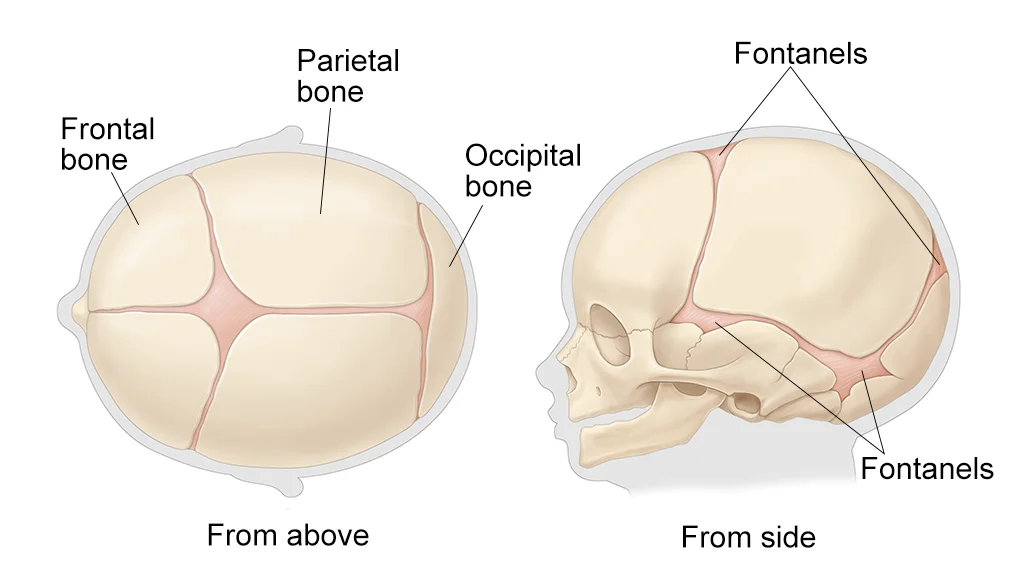
Look like! The journey through the birth canal can make your newborn’s head look misshapen and kind of pointy. Newborns also often develop a red and flaky scalp, called cradle cap. She may appear bowlegged until she starts walking. And don’t be surprised if your newborn loses weight during the first week. If your baby was premature, he may have thin, almost transparent skin that’s covered with a fine, downy hair called lanugo.
IN THIS ARTICLE
- What will my baby’s head look like?
- What will my baby’s body look like?
- What skin color will my baby have?
- What color hair will my baby have?
- What color eyes will my baby have?
- What will my baby’s ears look like?
- What will my baby’s nose look like?
Few newborns look like beauty contest winners, which isn’t surprising when you consider what they’ve been through. But is it really normal for their heads to be so pointy and their genitals so swollen? Here’s the top-to-toe scoop on why newborns look so, well, strange.
What will my baby’s head look like?
Your baby’s head may look a little misshapen or kind of pointy. This is called molding, and it happens as babies squeeze through the birth canal (or when a vacuum extractor is used during delivery). Your baby’s head should return to its original shape in a week or two.
C-section babies don’t come through the birth canal, so they have an edge in the looks department. Their heads come out nice and round because they don’t get squeezed, and their faces don’t get swollen like many babies delivered vaginally.
The soft spots on your baby’s head, called fontanels, are diamond-shaped openings in the skull covered by a thick layer of skin. These openings – one in front and one in back – allowed the bones of your baby’s skull to compress during his trip through the birth canal, and now they allow for the quick growth of his brain.

The rear fontanel takes about six months to close. The front one takes between 12 and 24 months.
Newborns often develop cradle cap – a redness and flakiness on the scalp. It usually goes away in a few weeks or months and is rarely uncomfortable or itchy. If you notice cradle cap on your baby, try washing his hair a little more often with a mild baby shampoo and brushing it with a soft-bristled brush. Don’t use medicated shampoos without checking with your baby’s doctor because they can irritate tender skin.
What will my baby’s body look like?
After spending so much time in the tight space of your uterus, your baby’s body may look curled up and need time to stretch out. Your baby’s arms and legs will uncurl in a week or two. When she does begin to stretch out, she’ll probably appear a bit bowlegged until she starts walking.
Some babies find swaddling – being wrapped snugly in a blanket – to be comforting because it mimics the tight quarters of the uterus.
Your baby might lose a little weight in his first week, but he should regain it during the second week and continue to put on the ounces and pounds at a fast clip in the following months, quickly filling out his belly.
After ten to 21 days, your baby’s umbilical cord stump falls off, leaving an adorable little belly button. Occasionally it also leaves a raw spot that may ooze a little blood-tinged fluid. Keep it dry and clean it with a cotton swab dipped in a little rubbing alcohol, and it should heal by itself. If the stump doesn’t fall off after a month, talk to your baby’s doctor.
The genitals and breasts of newborn boys and girls alike often appear swollen. This is caused by the extra dose of hormones just before birth.
A little milky substance may even leak from your baby’s nipples. Don’t try to squeeze out the liquid – it’s harmless and will dry up on its own. Girls may have some white discharge or blood-tinged vaginal mucus.
All of this will go away in the first few weeks.
What skin color will my baby have?
Babies of all races and ethnicities are born with reddish-purple skin that changes to pinkish-red in a day or so. The pink tint comes from the red blood vessels that are visible through your baby’s still-thin skin. Because your baby’s blood circulation is still maturing, his hands and feet may be bluish for a few days.
At first, your child’s skin is likely to be a shade or two lighter than her eventual skin color. The skin will darken and reach its natural color in the first two to three weeks.
Newborn skin varies in appearance according to how far along your baby is at birth. Premature babies have thin, almost transparent skin that may be covered with a fine, downy hair called lanugo. You’ll also see vernix, a cheesy, white substance that protects a baby’s delicate skin from the amniotic fluid. The farther along your pregnancy is when you deliver, the less lanugo and vernix your baby will have.
Some newborns have conditions that affect the skin such as:
- Jaundice. If your baby’s skin takes on a yellowish tinge in the first few days of life, he may have a slight case of jaundice. More than half of healthy newborns show signs of jaundice, which happens as the body breaks down extra red blood cells. Jaundice usually goes away in a week or so for full-term babies, but often hangs around slightly longer in preemies. It’s usually nothing to worry about, but mention it to your healthcare provider.
Jaundice that doesn’t go away may be a sign of a metabolic disorder or a liver problem. Your provider can do a simple blood or skin test to determine whether your baby needs treatment. He may have to spend some time under special lights that help his body get rid of the jaundice. - Milia. About 40 percent of babies are born with milia, small white or yellow dots on their face that look like tiny pimples. They usually disappear without treatment in three or four weeks.
- Pustular melanosis. If your baby has small, pus-filled bumps that leave dark brown marks when they burst, it’s probably pustular melanosis. This newborn rash is more common in African American babies. There’s no need to treat this condition. The marks will disappear by the time your baby is 3 or 4 months old.
- Erythema toxicum. A hive-like rash made up of red blotches with pale or yellowish bumps in the center is harmless despite its scary-sounding name. Called erythema toxicum, it usually appears a day or two after birth and is gone within a week.
- Acne isn’t unusual in new babies, either. About a fifth of newborns have a case of acne during their first month, the result of maternal hormones that circulate in the baby’s body after birth. Newborn acne is most likely to show up on the forehead and cheeks. It can worsen if your baby lies on sheets that have been washed in harsh detergents or soiled with spit-up. Place a soft, clean receiving blanket under his head while he’s awake, and wash his face gently once a day with a mild baby soap to remove detergent or milk residue. Otherwise, normal baby acne should disappear on its own within a few months once excess hormones dissipate.
- Birthmarks like congenital dermal melanocytosis (flat patches that look like ink stains, formerly called Mongolian Spots) and salmon patches (sometimes called angel kisses and stork bites) are also common. They come in a wide range of shapes, sizes, and colors and can show up anywhere on a baby’s body. Certain types of birthmarks may not appear for several days or weeks after birth. Most birthmarks are harmless. Many go away on their own in the first few years of life, although some, such as flat, reddish-purple marks called port-wine stains, are permanent.
What color hair will my baby have?
Be prepared for some surprises when it comes to your baby’s hair. African American babies can emerge with straight hair, dark-haired Caucasian couples can have children born with bright red or blond hair, and fair-haired parents have been presented with Elvis Presley look-alikes. And then there are the parents who wonder what color that peach fuzz is, exactly.
That said, newborn hair doesn’t tend to have much bearing on what your child’s hair will eventually look like. Even if your baby was born with a full head of hair, she may begin to lose some or all of it in the first few weeks or months. This often happens because babies spend so much time on their back.
Don’t worry – the hair will grow back, although it may return as a completely different color. Hair texture frequently changes in the first six months, too. You may find coarser, tighter ringlets growing in place of your baby’s loose, fine curls, for example.
What color eyes will my baby have?
Many African American, Asian, and Hispanic babies are born with dark gray-brown eyes that don’t change color significantly, but some may start out with hazel eyes that get darker as they approach 6 months. Most, though certainly not all, Caucasian babies are born with dark gray-blue eyes that can take months or years to reveal their permanent color.
Most often, the eye color you see at 6 to 9 months is the one that sticks around.
Sometimes newborns have red spots in the whites of their eyes. Though it may look alarming, it’s a harmless side effect of the trauma of birth. It’s called a subconjunctival hemorrhage and should go away within several days.
What will my baby’s ears look like?
Your baby’s ears may be soft and floppy, and one of the edges may be bent over a bit. As the cartilage in your baby’s ears becomes harder, her ears will become more defined.
What will my baby’s nose look like?
Your baby’s nose may look swollen from the pressure on it during delivery. It may also be a little flattened or even off-kilter. Don’t worry, he’ll look less like a prizefighter in just a few days.
Your baby’s appearance and behavior will change quite a bit in his first year of life. For information about your baby’s physical and emotional milestones, try our Baby Development area. And to stay up-to-date on what you can expect during all the stages of your baby’s first year, sign up for our weekly newsletters.
Read more about


Add a Comment